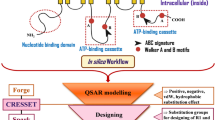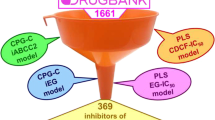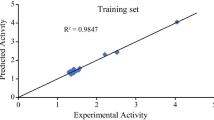Abstract
Human breast cancer resistance protein (BCRP) belongs to the G subfamily of ATP-binding cassette transporter. Over-expression of BCRP in cancer cells limits the efficacy of many chemotherapeutic agents, resulting in multiple drug resistance. A clear understanding of inhibitor-binding mode will be useful in the design of BCRP-selective inhibitor. To gain structural insights into the active site of BCRP, three-dimensional quantitative structure–activity relationship (3D-QSAR) models were developed for two different chemical series (flavonoids and chalcones derivatives) of BCRP inhibitors. Stable and statistically reliable predictive CoMFA and CoMSIA models have shown significant \(r_{\rm cv}^{2} > 0.7,\;r_{\rm ncv}^{2} > 0.9,\;r_{\rm bs}^{2} > 0.9,\;r_{\rm pred}^{2} > 0.6\) and a small standard deviation <0.2, indicating a better statistical relationship between the activity and descriptors. 3D contour maps generated from these models were analyzed individually, which provided the regions in space where interactive fields may influence the inhibitory activity of BCRP inhibitors. The similarity search between site points, generated from contour maps, and binding pockets identified using different pocket search tools, provided essential clues for characterization of the binding site. Molecular docking analysis reveals that Asp643, Asp650, and Val651 of the nucleotide-binding domain play an important role in binding of flavonoids and chalcones. The structural insights obtained from 3D-QSAR and molecular docking studies will serve as a guideline for designing and predicting novel BCRP inhibitors.








Similar content being viewed by others
References
Ahmed-Belkacem A, Pozza A, Munoz-Martinez F, Bates SE, Castanys S, Gamarro F, Di Pietro A, Pérez-Victoria JM (2005) Flavonoid structure-activity studies identify 6-prenylchrysin and tectochrysin as potent and specific inhibitors of breast cancer resistance protein ABCG2. Cancer Res 65(11):4852–4860
Ahmed-Belkacem A, Pozza A, Macalou S, Perez-Victoria JM, Boumendjel A, Di Pietro A (2006) Inhibitors of cancer cell multidrug resistance mediated by breast cancer resistance protein (BCRP/ABCG2). Anticancer Drugs 17(3):239–243
Allen JD, van Dort SC, Buitelaar M, van Tellingen O, Schinkel AH (2003) Mouse breast cancer resistance protein (Bcrp1/Abcg2) mediates etoposide resistance and transport, but etoposide oral availability is limited primarily by P-glycoprotein. Cancer Res 63(6):1339–1344
Allikmets R, Schriml LM, Hutchinson A, Romano-Spica V, Dean M (1998) A human placenta-specific ATP-binding cassette gene (ABCP) on chromosome 4q22 that is involved in multidrug resistance. Cancer Res 58(23):5337–5339
Ambure PS, Gangwal RP, Sangamwar AT (2012) 3D-QSAR and molecular docking analysis of biphenyl amide derivatives as p38α mitogen activated protein kinase inhibitors. Mol Divers 16:377–388
Boumendjel A, Macalou S, Ahmed-Belkacem A, Blanc M, Di Pietro A (2007) Acridone derivatives: design, synthesis, and inhibition of breast cancer resistance protein ABCG2. Bioorg Med Chem 15(8):2892–2897
Boumendjel A, Macalou S, Valdameri G, Pozza A, Gauthier C, Arnaud O, Nicolle E, Magnard S, Falson P, Terreux R (2011) Targeting the multidrug ABCG2 transporter with flavonoidic inhibitors: in vitro optimization and in vivo validation. Curr Med Chem 18(22):3387–3401
Colabufo NA, Berardi F, Perrone MG, Cantore M, Contino M, Inglese C, Niso M, Perrone R (2009) Multi-drug-resistance-reverting agents: 2-aryloxazole and 2-arylthiazole derivatives as potent BCRP or MRP1 inhibitors. ChemMedChem 4(2):188–195
Cooray HC, Blackmore CG, Maskell L, Barrand MA (2002) Localisation of breast cancer resistance protein in microvessel endothelium of human brain. NeuroReport 13(16):2059–2063
Doyle LA, Yang W, Abruzzo LV, Krogmann T, Gao Y, Rishi AK, Ross DD (1998) A multidrug resistance transporter from human MCF-7 breast cancer cells. Proc Natl Acad Sci USA 95(26):15665–15670
Gasteiger J, Marsili M (1980) Iterative partial equalization of orbital electronegativity—a rapid access to atomic charges. Tetrahedron 36(22):3219–3228
Glavinas H, Krajcsi P, Cserepes J, Sarkadi B (2004) The role of ABC transporters in drug resistance, metabolism and toxicity. Curr Drug Deliv 1(1):27–42
Gupta P, Garg P, Roy N (2011) Comparative docking and CoMFA analysis of curcumine derivatives as HIV-1 integrase inhibitors. Mol Divers 15(3):1–18
Hazai E, Bikádi Z (2008) Homology modeling of breast cancer resistance protein (ABCG2). J Struct Biol 162(1):63–74
Imai Y, Tsukahara S, Asada S, Sugimoto Y (2004) Phytoestrogens/flavonoids reverse breast cancer resistance protein/ABCG2-mediated multidrug resistance. Cancer Res 64(12):4346–4352
Jonker JW, Smit JW, Brinkhuis RF, Maliepaard M, Beijnen JH, Schellens JHM, Schinkel AH (2000) Role of breast cancer resistance protein in the bioavailability and fetal penetration of topotecan. J Natl Cancer Inst 92(20):1651–1656
Jonker JW, Buitelaar M, Wagenaar E, Van Der Valk MA, Scheffer GL, Scheper RJ, Plösch T, Kuipers F, Elferink RPJ, Rosing H (2002) The breast cancer resistance protein protects against a major chlorophyll-derived dietary phototoxin and protoporphyria. Proc Natl Acad Sci U S A 99(24):15649–15654
Juvale K, Pape VFS, Wiese M (2012) Investigation of chalcones and benzochalcones as inhibitors of breast cancer resistance protein. Bioorg Med Chem 20:346–355
Kage K, Tsukahara S, Sugiyama T, Asada S, Ishikawa E, Tsuruo T, Sugimoto Y (2002) Dominant-negative inhibition of breast cancer resistance protein as drug efflux pump through the inhibition of S–S dependent homodimerization. Int J Cancer 97(5):626–630
Kanzaki A, Toi M, Nakayama K, Bando H, Mutoh M, Uchida T, Fukumoto M, Takebayashi Y (2001) Expression of multidrug resistance-related transporters in human breast carcinoma. Cancer Sci 92(4):452–458
Katayama K, Masuyama K, Yoshioka S, Hasegawa H, Mitsuhashi J, Sugimoto Y (2007) Flavonoids inhibit breast cancer resistance protein-mediated drug resistance: transporter specificity and structure–activity relationship. Cancer Chemother Pharmacol 60(6):789–797
Maliepaard M, van Gastelen MA, de Jong LA, Pluim D, van Waardenburg RCAM, Ruevekamp-Helmers MC, Floot BGJ, Schellens JHM (1999) Overexpression of the BCRP/MXR/ABCP gene in a topotecan-selected ovarian tumor cell line. Cancer Res 59(18):4559–4563
Maliepaard M, Scheffer GL, Faneyte IF, van Gastelen MA, Pijnenborg ACLM, Schinkel AH, van de Vijver MJ, Scheper RJ, Schellens JHM (2001) Subcellular localization and distribution of the breast cancer resistance protein transporter in normal human tissues. Cancer Res 61(8):3458–3464
Miyake K, Mickley L, Litman T, Zhan Z, Robey R, Cristensen B, Brangi M, Greenberger L, Dean M, Fojo T (1999) Molecular cloning of cDNAs which are highly overexpressed in mitoxantrone-resistant cells. Cancer Res 59(1):8–13
Morris GM, Goodsell DS, Halliday RS, Huey R, Hart WE, Belew RK, Olson AJ (1998) Automated docking using a Lamarckian genetic algorithm and an empirical binding free energy function. J Comput Chem 19(14):1639–1662
Nakanishi T, Doyle LA, Hassel B, Wei Y, Bauer KS, Wu S, Pumplin DW, Fang HB, Ross DD (2003) Functional characterization of human breast cancer resistance protein (BCRP, ABCG2) expressed in the oocytes of Xenopus laevis. Mol Pharmacol 64(6):1452–1462
Nandi S, Bagchi MC (2010) 3D-QSAR and molecular docking studies of 4-anilinoquinazoline derivatives: a rational approach to anticancer drug design. Mol Divers 14(1):27–38
Nicolle E, Boccard J, Guilet D, Dijoux-Franca M-G, Zelefac F, Macalou S, Grosselin J, Schmidt J, Carrupt P-A, Di Pietro A (2009a) Breast cancer resistance protein (BCRP/ABCG2): new inhibitors and QSAR studies by a 3D linear solvation energy approach. Eur J Pharm Sci 38(1):39–46
Nicolle E, Boccard J, Guilet D, Dijoux-Franca MG, Zelefac F, Macalou S, Grosselin J, Schmidt J, Carrupt PA, Di Pietro A (2009b) Breast cancer resistance protein (BCRP/ABCG2): new inhibitors and QSAR studies by a 3D linear solvation energy approach. Eur J Pharm Sci 38(1):39–46
Pick A, Müller H, Wiese M (2008) Structure–activity relationships of new inhibitors of breast cancer resistance protein (ABCG2). Bioorg Med Chem 16(17):8224–8236
Pick A, Müller H, Wiese M (2010) Novel lead for potent inhibitors of breast cancer resistance protein (BCRP). Bioorg Med Chem Lett 20(1):180–183
Pick A, Müller H, Mayer R, Haenisch B, Pajeva IK, Weigt M, Bönisch H, Müller CE, Wiese M (2011) Structure–activity relationships of flavonoids as inhibitors of breast cancer resistance protein (BCRP). Bioorg Med Chem 19(6):2090–2102
Powell MJD (1977) Restart procedures for the conjugate gradient method. Math Program 12(1):241–254
Robey RW, Medina-Pérez WY, Nishiyama K, Lahusen T, Miyake K, Litman T, Senderowicz AM, Ross DD, Bates SE (2001) Overexpression of the ATP-binding cassette half-transporter, ABCG2 (Mxr/BCrp/ABCP1), in flavopiridol-resistant human breast cancer cells. Clin Cancer Res 7(1):145–152
Ross DD, Karp JE, Chen TT, Doyle LA (2000) Expression of breast cancer resistance protein in blast cells from patients with acute leukemia. Blood 96(1):365–368
Singh U, Gangwal RP, Dhoke GV, Prajapati R, Damre M, Sangamwar AT (2012) 3D-QSAR and molecular docking analysis of (4-piperidinyl)-piperazines as acetyl-CoA carboxylases inhibitors. Arabian J Chem. doi:10.1016/j.arabjc.2012.10.023
Szakács G, Paterson JK, Ludwig JA, Booth-Genthe C, Gottesman MM (2006) Targeting multidrug resistance in cancer. Nat Rev Drug Discov 5(3):219–234
Valdameri G, Genoux-Bastide E, Peres B, Gauthier C, Guitton J, Terreux R, Winnischofer SMB, Rocha MEM, Boumendjel A, Di Pietro A (2012) Substituted chromones as highly-potent nontoxic inhibitors, specific for the breast cancer resistance protein. J Med Chem 55:966–970
van der Kolk DM, Vellenga E, Scheffer GL, Muller M, Bates SE, Scheper RJ, de Vries EGE (2002) Expression and activity of breast cancer resistance protein (BCRP) in de novo and relapsed acute myeloid leukemia. Blood 99(10):3763–3770
Volk EL, Farley KM, Wu Y, Li F, Robey RW, Schneider E (2002) Overexpression of wild-type breast cancer resistance protein mediates methotrexate resistance. Cancer Res 62(17):5035–5040
Wang X, Furukawa T, Nitanda T, Okamoto M, Sugimoto Y, Akiyama SI, Baba M (2003) Breast cancer resistance protein (BCRP/ABCG2) induces cellular resistance to HIV-1 nucleoside reverse transcriptase inhibitors. Mol Pharmacol 63(1):65–72
Xu J, Liu Y, Yang Y, Bates S, Zhang JT (2004) Characterization of oligomeric human half-ABC transporter ATP-binding cassette G2. J Biol Chem 279(19):19781
Zhang S, Yang X, Coburn RA, Morris ME (2005) Structure activity relationships and quantitative structure activity relationships for the flavonoid-mediated inhibition of breast cancer resistance protein. Biochem Pharmacol 70(4):627–639
Acknowledgments
The authors acknowledge financial support from the council of scientific and industrial research (CSIR), New Delhi.
Author information
Authors and Affiliations
Corresponding author
Additional information
Kanchan Khandelwal and Rahul Prakashchand Gangwal contributed equally.
Electronic supplementary material
Below is the link to the electronic supplementary material.
Rights and permissions
About this article
Cite this article
Khandelwal, K., Gangwal, R.P., Singh, U. et al. Computational insights into the active site of human breast cancer resistance protein (BCRP/ABCG2): a similarity search approach. Med Chem Res 23, 4657–4668 (2014). https://doi.org/10.1007/s00044-014-1035-8
Received:
Accepted:
Published:
Issue Date:
DOI: https://doi.org/10.1007/s00044-014-1035-8




